Estonia, like many other countries, is facing a variety of environmental challenges that threaten the well-being of its ecosystems and its inhabitants. These issues have been caused by a combination of factors, including rapid economic growth, urbanization, and climate change.
- Biodiversity loss: The loss of biodiversity in Estonia has been a result of overfishing, deforestation, and other human activities that have caused declines in populations of many of the country's unique species.
- Water pollution: Agricultural and industrial waste have contaminated many of Estonia's rivers and lakes, affecting the quality of the water and the health of local communities who rely on them for drinking water and recreation.
- Air pollution: Estonia's heavy dependence on oil shale as a source of energy has led to high levels of air pollution, which has contributed to respiratory and cardiovascular problems among its residents.
- Soil degradation: Intensive agriculture practices, deforestation, and urbanization have all led to soil degradation in Estonia, reducing its ability to support crops and vegetation.
- Climate change: Estonia is facing the impacts of rising temperatures and changing weather patterns, which are affecting its ecosystems and wildlife, as well as its agriculture and tourism industries.
- Littering and waste management: Improper waste disposal, particularly of plastic waste, has led to littering and pollution in Estonia's forests, parks, and waterways.
In conclusion, it is essential for Estonia to address these environmental issues in order to ensure a sustainable future for its people and its ecosystems
Biodiversity Loss
Biodiversity loss refers to the decline in the variety of species and ecosystems in a given area, and it can have significant impacts on the environment. In Estonia, biodiversity loss is driven by a variety of factors, including habitat destruction, overexploitation, and climate change. The following are six specific effects of biodiversity loss on the environment in Estonia.
- Loss of ecosystem services: Biodiversity loss can result in the loss of critical ecosystem services, such as pollination, pest control, and nutrient cycling. In Estonia, the loss of pollinators due to habitat destruction and pesticide use has led to reduced crop yields and increased food insecurity.
- Decline in population numbers of native species: Biodiversity loss can result in declines in the population numbers of native species, leading to increased risk of extinction. In Estonia, the loss of wetlands due to drainage and urbanization has led to declines in waterfowl populations, including threatened species such as the bittern.
- Alteration of food webs: Biodiversity loss can result in the alteration of food webs and ecosystems, leading to cascading effects on other species and the environment. In Estonia, the loss of top predators such as wolves and lynx has led to increased populations of their prey species, which has in turn had negative impacts on vegetation and other wildlife.
- Reduced resilience to environmental change: Biodiversity loss can reduce the resilience of ecosystems to environmental change, such as droughts, fires, and extreme weather events. In Estonia, the loss of diverse plant communities due to deforestation and land use changes has reduced the resilience of the landscape to extreme weather events, such as heatwaves and drought.
- Reduced carbon sequestration: Biodiversity loss can also result in reduced carbon sequestration, or the ability of ecosystems to absorb and store carbon dioxide from the atmosphere. In Estonia, the loss of forests due to logging and urbanization has reduced the country's ability to sequester carbon and mitigate the effects of climate change.
- Impacts on human well-being: Biodiversity loss can also have negative impacts on human well-being, including reduced access to food, medicine, and recreation opportunities. In Estonia, the loss of wildflower meadows due to land use changes has reduced opportunities for recreation and recreation-based tourism.
In conclusion, biodiversity loss is a significant environmental challenge in Estonia and can have far-reaching impacts on the environment, human well-being, and the economy. It is important to take action to protect and conserve biodiversity, including through habitat protection, sustainable land use practices, and reduction of the drivers of biodiversity loss, such as climate change and overexploitation.
Water Pollution 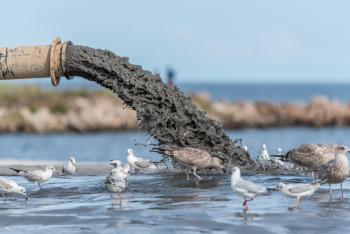
Water pollution refers to the presence of harmful substances or pollutants in water bodies that can cause adverse effects on the environment and human health. In Estonia, water pollution is caused by a variety of sources, including agricultural runoff, industrial discharges, and municipal waste. The following are six specific effects of water pollution on the environment in Estonia.
- Impacts on aquatic life: Water pollution can have significant impacts on aquatic life, including fish, crustaceans, and other aquatic organisms. In Estonia, the discharge of industrial chemicals into rivers and lakes has led to declines in fish populations and reductions in the diversity of aquatic species.
- Contamination of drinking water: Water pollution can result in the contamination of drinking water sources, posing risks to human health and well-being. In Estonia, pollution from agricultural runoff and industrial discharges has resulted in the contamination of groundwater sources, leading to health risks for local communities.
- Harm to recreational activities: Water pollution can also have negative impacts on recreational activities, such as fishing, boating, and swimming. In Estonia, the discharge of pollutants into lakes and rivers has made these bodies of water unsafe for recreational activities, leading to reductions in tourism and local economic activity.
- Eutrophication: Water pollution can also result in eutrophication, or the excessive growth of algae and other aquatic plants due to an overabundance of nutrients in the water. In Estonia, agricultural runoff containing excess nitrogen and phosphorus has led to eutrophication of lakes and rivers, resulting in reduced oxygen levels and harm to aquatic life.
- Reduced biodiversity: Water pollution can also result in reduced biodiversity, as pollutants can harm or kill aquatic organisms, leading to declines in the number and diversity of species. In Estonia, the discharge of toxic chemicals into rivers and lakes has led to declines in amphibian populations and reductions in the diversity of aquatic species.
- Negative impacts on ecosystem function: Water pollution can also have negative impacts on the function of aquatic ecosystems, including reductions in primary productivity and alterations in nutrient cycling. In Estonia, pollution from agricultural runoff and industrial discharges has altered the nutrient balance of lakes and rivers, leading to reductions in primary productivity and harm to aquatic life.
In conclusion, water pollution is a significant environmental challenge in Estonia and can have far-reaching impacts on the environment, human health, and the economy. It is important to take action to reduce and prevent water pollution, including through the implementation of best management practices for agriculture, regulation of industrial discharges, and improvements in waste management practices.
Air Pollution 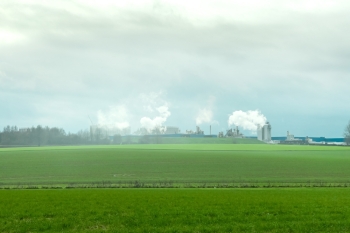
Air pollution is a significant environmental issue in Estonia and is having significant impacts on the health of its people and the environment. Some of the specific effects of air pollution include:
- Human health impacts: Air pollution can cause respiratory problems, such as asthma and bronchitis, as well as cardiovascular disease and cancers.For example, air pollution in Tallinn, the capital of Estonia, has been linked to increased hospital admissions for respiratory problems.
- Ecosystem impacts: Air pollution can impact ecosystems, including forests, rivers, and wetlands. For example, acid rain caused by air pollution can alter the pH levels of soils and water bodies, leading to declines in fish populations and changes in the composition of plant communities.
- Climate change: Air pollution, including greenhouse gas emissions, contributes to climate change. Increased emissions of carbon dioxide from burning fossil fuels in Estonia can contribute to global temperature rises and changes in weather patterns.
- Soil contamination: Air pollution can deposit contaminants on the surface of the soil, leading to soil contamination. The deposition of heavy metals and other toxic substances can harm plant and animal life, reducing biodiversity and ecosystem health.
- Visibility reduction: Air pollution can reduce visibility, making it difficult to see distant objects, including natural landmarks and wildlife. Haze caused by air pollution can obscure views of the beautiful landscapes of Estonia.
- Property damage: Air pollution can cause damage to buildings, statues, and other property. Acid rain can cause corrosion of metal surfaces and stonework, leading to damage to historical monuments and other cultural heritage sites.
In order to reduce the impacts of air pollution, Estonia must take action to reduce emissions from sources such as transportation, industry, and energy production. This can include promoting clean energy sources, improving vehicle emissions standards, and implementing air quality management plans. By working together, the government, businesses, and communities can help ensure a healthy and sustainable future for Estonia.
Soil Degradation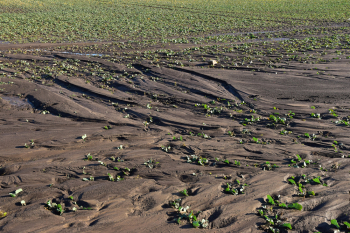
Soil degradation is a major environmental issue in Estonia, affecting the health of its ecosystems and its ability to support productive agriculture. Some of the specific effects of soil degradation include:
- Reduced agricultural productivity: Soil degradation can reduce the fertility and productivity of agricultural land, leading to reduced yields and economic losses for farmers. Soil degradation due to overuse of agricultural chemicals, overgrazing, and soil erosion can lead to decreased crop production and reduced quality of crops grown in Estonia.
- Increased soil erosion: Soil degradation can lead to increased soil erosion, which can result in the loss of valuable topsoil, reduced soil fertility, and increased runoff of pollutants into waterways. Soil erosion caused by changes in land use, such as deforestation or urbanization, can result in increased sedimentation in rivers, affecting aquatic habitats and reducing water quality.
- Reduced biodiversity: Soil degradation can impact the diversity of plant and animal species, reducing the resilience of ecosystems to change. Declines in soil health due to degradation can reduce the number of plant species, making ecosystems less able to support wildlife populations.
- Contamination: Soil degradation can result in soil contamination, which can harm human health and wildlife. Soil degradation caused by the release of toxic chemicals, such as heavy metals, into the environment can contaminate the soil and food chains, causing health problems for humans and wildlife.
- Land degradation: Soil degradation can lead to land degradation, resulting in the loss of valuable farmland and reducing the ability of land to support human and wildlife populations. Soil degradation due to salinization, desertification, or urbanization can result in the loss of valuable agricultural land and reductions in the ability of the land to support wildlife populations.
- Climate change: Soil degradation can contribute to climate change by reducing the ability of soil to store carbon, leading to increased emissions of carbon dioxide into the atmosphere. Soil degradation due to deforestation or degradation of peatlands can result in the release of large amounts of carbon dioxide into the atmosphere, contributing to global warming.
In order to address soil degradation, Estonia must take a multi-pronged approach that includes reducing soil degradation, conserving soil health, and promoting sustainable land use practices. This can include promoting conservation agriculture, reducing soil erosion, improving soil management practices, and protecting areas of high soil conservation value. By working together, the government, businesses, and communities can help ensure a healthy and sustainable future for Estonia.
Climate Change 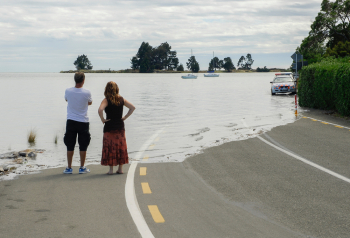
Climate change has a significant impact on the environment in Estonia. The following are six of the specific effects that have been observed:
- Rising temperatures: Estonia has experienced an increase in temperatures in recent years, leading to changes in precipitation patterns and the length of growing seasons.
- For example, the average temperature in Estonia has risen by 1.5°C over the past century, which has resulted in the melting of glaciers and the shift of the range of many plant and animal species.
- Changes in precipitation: Estonia has experienced changes in precipitation patterns, which can impact water availability and increase the risk of flooding and erosion. There has been a decrease in rainfall in the summer months, which has resulted in a decrease in water levels in rivers and lakes and an increase in the risk of forest fires.
- Sea level rise: The rising sea levels caused by climate change pose a threat to coastal areas in Estonia, particularly those near the Gulf of Finland. The low-lying islands near Tallinn are vulnerable to flooding and erosion from rising sea levels, which can result in the loss of habitats for coastal wildlife.
- Impacts on biodiversity: Climate change has the potential to impact the biodiversity of Estonia, particularly by altering the distribution and abundance of species. Many species of birds are shifting their ranges northward as temperatures rise, which can result in the loss of habitats and reduced populations.
- Increased risk of wildfires: Climate change can increase the risk of wildfires in Estonia, particularly in areas with low rainfall and high temperatures. There has been an increase in the number of forest fires in recent years, which can result in the loss of habitats, reduced biodiversity, and increased carbon emissions.
- Increased risk of droughts: Climate change can increase the risk of droughts in Estonia, particularly in areas with low rainfall. The southern regions of Estonia have experienced droughts in recent years, which has resulted in a decrease in water levels in rivers and lakes, reduced crop yields, and increased water stress.
In conclusion, climate change has significant impacts on the environment in Estonia, including changes in temperature, precipitation, sea levels, biodiversity, and the risk of wildfires and droughts. It is important to take action to mitigate these impacts and reduce the risk of further harm to the environment.
Littering and Waste Management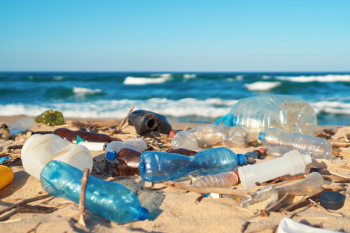
Littering and poor waste management are significant environmental issues facing Estonia. Poor waste management practices can lead to a range of negative impacts on the environment, including:
- Soil contamination: Litter, especially plastic waste, can seep into the soil and contaminate it, leading to harm to plants, animals and microorganisms in the soil. Discarded plastic bags can suffocate the roots of plants and release toxic chemicals into the soil.
- Water pollution: Litter can also pollute bodies of water, such as rivers, lakes, and oceans, and have detrimental effects on aquatic life and water quality. Discarded fishing nets and plastic waste can entangle and suffocate marine life.
- Air pollution: The burning of waste, especially plastic, releases harmful chemicals into the air, contributing to air pollution. Burning of waste in open dump sites can release toxic fumes that can cause respiratory problems in nearby residents.
- Loss of biodiversity: Litter can alter habitats and cause harm to wildlife, reducing biodiversity in an ecosystem. Discarded fishing nets can entangle and harm birds and marine life.
- Health risks: Improper waste management practices can pose health risks to both humans and animals. Discarded syringes and broken glass can pose physical harm to children and animals, while rotting waste can release harmful gases that can cause respiratory problems.
- Climate change: Landfills, where waste is often deposited, can release methane gas, which is a potent greenhouse gas contributing to climate change. The overflowing of landfills can cause litter to enter the atmosphere and release methane gas into the air.
In conclusion, littering and poor waste management practices can have serious consequences on the environment in Estonia. Addressing this issue through proper waste management, reduction, and recycling can help mitigate these effects and protect the environment.
Copyright © 1993-2025 World Trade Press. All rights reserved.

